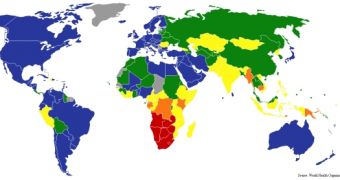Tough one third of the world's population is infected with Mycobacterium tuberculosis, the bacterium that causes pulmonary tuberculosis (TB), only 5 to 10 percent of them will ever develop the disease in its active state. Why this happens remains a mystery to this day, but researchers think they may have had a breakthrough in the matter, with the discovery of a gene dubbed Toll-like receptor 8 (TLR8), that is believed to raise the susceptibility to tuberculosis in people carrying the virus.
The Genome Institute of Singapore (GIS) funded the study, which was published in the PLoS Genetics journal today (October 10th). "Our analysis of the results from cohort studies in Indonesia and Russia suggested that susceptibility was attributed to genetic variants of TLR8, which is located at the X chromosome," said Dr. Sonia Davila, researcher at GIS and lead author of the study. "We hope that it [TLR8] will increase our understanding of the disease process of pulmonary tuberculosis."
The research also showed that males have a higher risk of contracting pulmonary tuberculosis than females. The disease acts by damaging lung cells, rendering them incapable of processing inhaled air and, thus, depriving the brain of oxygen. "The team (...) has made an important new discovery of an alternative cellular receptor for one of the world's most important infectious agents, M. tuberculosis, the causative agent of TB," said Paul MacAry, assistant professor at the National University of Singapore's Graduate School for Integrative Sciences and Engineering.
With identifying TLR8 as an agent in TB development, scientists worldwide hope to soon be able to devise new means of treating and even curing the deadly disease, which causes more than 1.5 million deaths each year. "The identification of a role for TLR8 in TB infection has the potential to open up new areas of exploration in TB host/pathogen interactions and provide researchers and clinician scientists with novel targets for therapeutic intervention," MacAry added. Focus groups from Indonesia, Singapore, the UK, Russia and the Netherlands contributed to this international effort.

 14 DAY TRIAL //
14 DAY TRIAL //